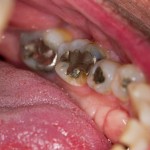
Caries remains a very common disease and a range of restorative techniques and materials are available to restore affected teeth. Amalgam has been used as a restorative material for over 100 years proving to be a cost effective material. Its appearance and inability to bond to existing tooth surfaces are important limitations. However, developments of bonding systems may help improve retention.
The aim of this review was to assess the effects of adhesive bonding on the in-service performance and longevity of dental amalgam restorations.
Methods
Searches were conducted in the Cochrane Oral Health Group Trials Register, Cochrane Central Register of Controlled Trials (CENTRAL), Medline, Embase, US National Institutes of Health Trials Register, and the WHO International Clinical Trials Registry Platform without restriction of language or date.
Randomised controlled trials comparing adhesively bonded amalgams versus traditional non-bonded amalgam restorations in conventional preparations utilising deliberate retention, in adults with permanent molar and premolar teeth suitable for Class I and II amalgam restorations .Two reviewers independently selected studies abstracted data and assessed study quality. The Cochrane risk of bias tool was used to assess quality.
Results
- One trial with unclear risk of bias involving 31 patients who received 113 restorations was included.
- At two years, 50 out of 53 restorations in the non-bonded group survived, and 55 of 60 bonded restorations survived with five unaccounted for at follow-up.
- Post-insertion sensitivity was not significantly different (P > 0.05) at baseline or two-year follow-up.
- No fractures of tooth tissue were reported and there was no significant difference between the groups or matched pairs of restorations in their marginal adaptation (P > 0.05).
Conclusions
The authors concluded
There is no evidence to either claim or refute a difference in survival between bonded and non-bonded amalgam restorations. This review only found one under-reported trial. This trial did not find any significant difference in the in-service performance of moderately sized adhesively bonded amalgam restorations, in terms of their survival rate and marginal integrity, in comparison to non-bonded amalgam restorations over a two-year period. In view of the lack of evidence on the additional benefit of adhesively bonding amalgam in comparison with non-bonded amalgam, it is important that clinicians are mindful of the additional costs that may be incurred.
Comments
This review is an update of an earlier Cochrane review of this topic and follows the usual Cochrane methodological approaches. While reviews have shown that amalgam remains an effective filing material (Dental Elf – 7th Apr 2014) improvements in tooth coloured materials and a move to minimally invasive approaches is leading to a decline in both its usage and research into improving its performance. This and potential additional costs of amalgam bonding are raised by the review authors as potential reasons for the limited numbers of studies available. Following the signing of the Minamata Convention on Mercury in 2013 the phasing down of the use of amalgam has also been agreed which is also likely to have an effect on research in this area.
Links
Primary paper
Agnihotry A, Fedorowicz Z, Nasser M. Adhesively bonded versus non-bonded amalgam restorations for dental caries. Cochrane Database of Systematic Reviews 2016, Issue 3. Art. No.: CD007517. DOI: 10.1002/14651858.CD007517.pub3.
Other references
Dental Elf -13th Jul 2015 – Amalgam has lower failure rate than composite in restorations
Dental Elf – 7th Apr 2014 – Amalgam still an effective filling material for posterior teeth

Do adhesively bonded amalgam restorations perform better than non-bonded amalgams? https://t.co/ofSGx8eZCy
Adhesively bonded amalgams – insufficient evidence of better performance https://t.co/ofSGx8eZCy
Insufficient evidence of better performance with adhesively bonded amalgams https://t.co/ofSGx8eZCy
Review finds insufficient evidence of better performance of bonded amalgams https://t.co/ofSGx8eZCy
Insufficient evidence that adhesively bonded amalgam restorations perform better than non-bonded amalgams https://t.co/ofSGx8eZCy
Don’t miss – Adhesively bonded amalgams – insufficient evidence of better performance https://t.co/ofSGx8eZCy